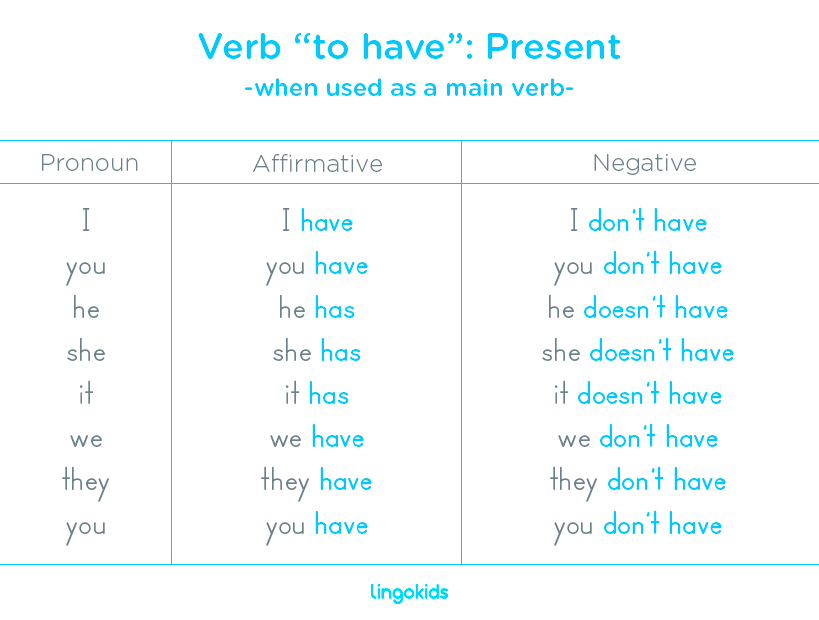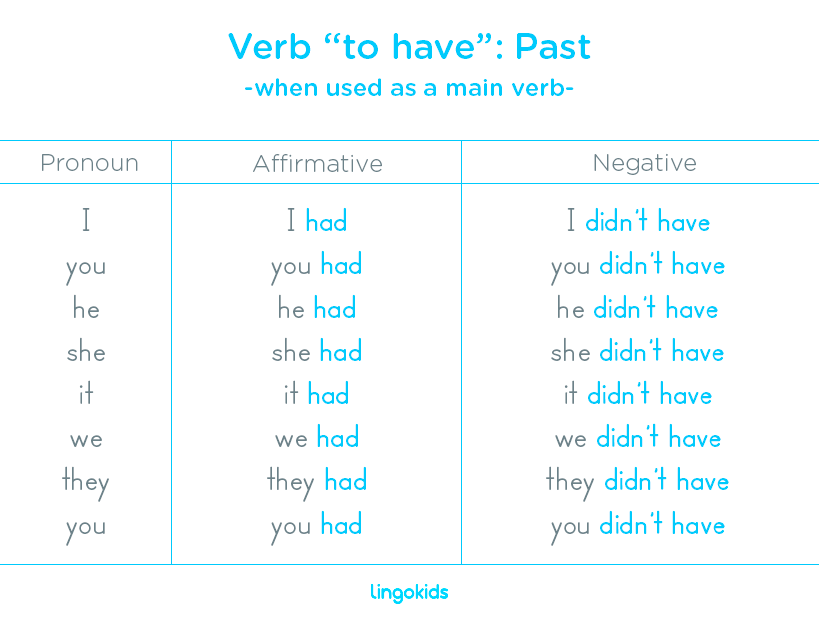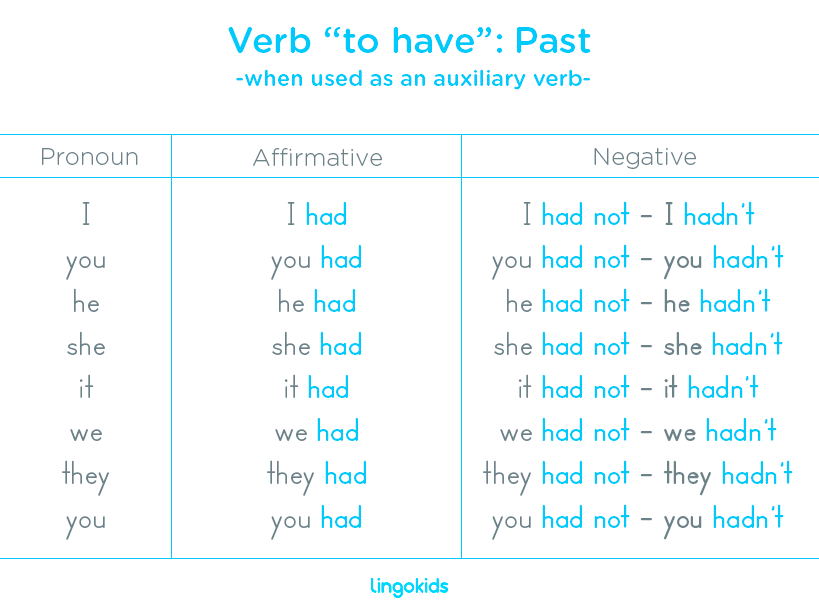The verb HAVE can function as a main verb and as an auxiliary verb. The forms of the verb HAVE in the simple present are I/we/you/they have, he/she/it has; the simple past for all persons – had. The verb HAVE is also used in a large number of set expressions and in several commonly used phrases, such as «have got, have to, have got to, had better, have something done».
HAVE as a main verb
Main meanings of the verb HAVE as a main verb are «own, possess». In these meanings, the verb HAVE is a stative verb and is not used in the Continuous tenses.
He has a large house.
He has blue eyes and dark hair.
They have two cats and a dog.
She has a lot of friends.
I have a lot of work today.
He has a sense of humor.
We have the right to do it.
The phrase HAVE GOT is used as a synonym for the verb HAVE in the meaning «to own, to possess» in the present tense, especially in everyday speech. Examples: She’s got gray eyes. I’ve got a new computer. (Differences in the use of HAVE and HAVE GOT are described in Russian in the commentary to the song Gary Moore — Still Got the Blues in the section Hobby.)
HAVE as a main verb is used in a large number of set expressions in which it may keep or lose the meaning «own, possess». For example: to have breakfast, have dinner, have a cup of coffee, have a sandwich, have a good time, have fun, have an opportunity, have a problem, have difficulty, have a question, have a look, have a walk, have a talk, have a fight, have an accident, have a bath, have a baby, have a cold, have a headache, have patience, have influence, have something against someone, have a taste for something.
In a number of set expressions denoting some activity or process, for example, «to have dinner, have fun, have a walk, have a bath», the verb HAVE can be used in the Continuous tenses.
They are having breakfast now.
She writes that she is having a good time.
We are having a party next Saturday.
When I came in, he was having a talk with the manager.
HAVE as a main verb forms questions and negative sentences in the simple present and simple past with the help of the auxiliary verb DO.
Does he have a telephone? – Yes, he does.
Do you have a sister? – No, I don’t.
Did you have a look at my report?
What do you have in mind?
He has a car, doesn’t he?
He had a cold yesterday, didn’t he?
I don’t have a dictionary of British slang.
He doesn’t have any friends.
I didn’t have time yesterday.
Note: Some negative sentences with HAVE can be formed with the help of NO before the noun. Examples: He has no friends. They have no children. I have no questions. I had no time yesterday.
HAVE as an auxiliary verb
The verb HAVE is used as an auxiliary verb in the formation of the perfect tenses and of the perfect continuous tenses.
He has already written the report.
She has been waiting for two hours.
We had finished work by the time he came back.
He will have left before you wake up.
The verb HAVE as an auxiliary verb forms questions and negative sentences on its own.
Have you ever been to Australia?
How long has she been sleeping?
You have read it, haven’t you?
She hasn’t called him yet.
Students sometimes have a problem understanding sentences in which the auxiliary verb HAVE and the main verb HAVE are used together. You just need to remember that the tense form for the perfect tenses is have + past participle of the main verb, for example, «have written, has written, had written, will have written». And if the main verb in the sentence happens to be HAVE, then the tense forms will be «have had, has had, had had, will have had». Look at these sentences in which the first HAVE is an auxiliary verb that helps to form the present perfect tense, and the second HAVE is a main verb.
He has had a hard life.
She has had a headache for three days.
We haven’t had any free time lately.
I’ve had enough of your criticism!
I’ve had it!
The phrase HAVE TO
The verb HAVE expresses modality in the phrase HAVE TO in the meaning «necessity». The phrase HAVE TO, i.e., have + infinitive with the particle «to», is used as the most common substitute for the modal verb MUST in the meaning «necessity».
I must talk to him about it. – I have to talk to him about it.
I must write a report today. – I have to write a report today.
I had to go there yesterday, and I will have to go there again tomorrow.
Does he have to stay here till eight?
You don’t have to sell your car.
The phrase HAVE GOT TO is used as a synonym for HAVE TO and MUST in the present in informal speech. Examples: I’ve got to talk to him about it. I’ve got to write a report today. Differences in their use are described in Necessity in the section Grammar.
Note: The phrase HAD BETTER is used as a synonym for SHOULD and OUGHT TO for giving advice. Example: Your cough is getting worse; you’d better see a doctor. HAD BETTER is described in Advice in the section Grammar.
Construction «have something done»
The construction «have something done», i.e., have + object + past participle, is one of the types of the construction verb + complex object. It is widely used in describing the actions performed for you by someone else, usually in the form of services rendered to you by service companies.
I had my hair cut yesterday.
He had his car washed.
She had the door painted and a new lock installed.
Did you have the car repaired yesterday?
I had it done last week.
Where can I have my car washed?
Where can I have my bicycle repaired?
Can I have this suit cleaned and pressed for tomorrow?
In some cases, the verb GET can replace the verb HAVE in this construction in everyday speech.
I got my car washed.
Where can I get it done?
Note that the same construction with the verb HAVE may have another meaning:
She had all her money stolen. (Someone stole all her money. All her money was stolen.)
«Someone» may also be used (instead of «something») in such constructions with the verb HAVE. For example:
She had him arrested. (She caused the police to arrest him.)
You had me worried. (I was worried about you. You made me worry.)
He had us laughing. (We were laughing because of him. He made us laugh.)
The construction «have someone do something» has the following meaning: to ensure (to cause, request, ask) that someone performs some action. In everyday speech, «get someone to do something» may be used (meaning: to ask, to persuade someone to do something). You can replace these constructions with simpler constructions in your speech.
Have him call me, please. – Ask him to call me, please.
Have Anita type the letters. – Tell Anita to type the letters.
I got him to repair my bicycle. – I asked / persuaded him to repair my bicycle.
Глагол HAVE
Глагол HAVE может работать как основной глагол и как вспомогательный глагол. Формы глагола HAVE в простом настоящем времени – I/we/you/they have, he/she/it has; простое прошедшее для всех лиц – had. Глагол HAVE также употребляется в большом количестве устойчивых выражений и в нескольких широко употребительных фразах, таких как «have got, have to, have got to, had better, have something done».
HAVE как основной глагол
Главные значения глагола HAVE как основного глагола – иметь, обладать. В этих значениях HAVE является глаголом состояния и не употребляется во временах группы Continuous.
У него есть (Он имеет) большой дом.
У него голубые глаза и темные волосы.
У них две кошки и собака.
У неё очень много друзей.
У меня очень много работы сегодня.
У него есть чувство юмора.
Мы имеем право сделать это.
Фраза HAVE GOT употребляется как синоним для глагола HAVE в значении «иметь, обладать» в настоящем времени, особенно в разговорной речи. Примеры: She’s got gray eyes. (У неё серые глаза.) I’ve got a new computer. (У меня новый компьютер.) (Различия в употреблении HAVE и HAVE GOT описаны на русском языке в комментарии к песне Gary Moore — Still Got the Blues в разделе Hobby.)
Глагол HAVE как основной глагол употребляется в большом количестве устойчивых выражений, в которых он может сохранять или терять значение «иметь, обладать». Например: завтракать, обедать, выпить чашку кофе, съесть бутерброд, хорошо провести время, веселиться, иметь возможность, иметь проблему, иметь трудность, иметь вопрос, посмотреть, погулять, поговорить, поссориться, попасть в аварию, принимать ванну, родить ребенка, простудиться, страдать от головной боли, иметь терпение, иметь влияние, иметь что-то против кого-то, иметь склонность к чему-то.
В ряде устойчивых выражений, обозначающих какую-либо деятельность или процесс, например, «to have dinner, have fun, have a walk, have a bath», глагол HAVE может употребляться во временах группы Continuous.
Они сейчас завтракают.
Она пишет, что она хорошо проводит время.
У нас будет вечеринка в следующую субботу.
Когда я вошел, он разговаривал с менеджером.
HAVE как основной глагол образует вопросы и отрицательные предложения в простом настоящем и простом прошедшем с помощью вспомогательного глагола DO.
У него есть телефон? – Да, есть.
У вас есть сестра? – Нет, нет.
Вы посмотрели мой доклад?
Что вы имеете в виду?
У него есть машина, не так ли?
У него вчера была простуда, не так ли?
У меня нет словаря британского сленга.
У него нет друзей.
У меня не было времени вчера.
Примечание: Некоторые отрицательные предложения с HAVE можно образовать помощью NO перед существительным. Примеры: У него нет друзей. У них нет детей. У меня нет вопросов. У меня не было времени вчера.
HAVE как вспомогательный глагол
Глагол HAVE употребляется как вспомогательный глагол для образования перфектных времен и перфектных продолженных времен.
Он уже написал доклад.
Она прождала / ждет уже два часа.
Мы уже закончили работу к тому времени, как он вернулся.
Он уедет до того, как ты проснешься.
Глагол HAVE как вспомогательный глагол образует вопросы и отрицательные формы самостоятельно.
Вы когда-нибудь бывали в Австралии?
Как долго она уже спит?
Вы это прочитали, не так ли?
Она ему еще не звонила.
Студенты иногда испытывают трудность с пониманием предложений, в которых вспомогательный глагол HAVE и основной глагол HAVE употреблены вместе. Просто нужно помнить, что форма времени для перфектных времен – have + причастие прошедшего времени основного глагола, например, «have written, has written, had written, will have written». А если так получилось, что основной глагол в предложении – HAVE, то формы времен будут «have had, has had, had had, will have had». Посмотрите на эти предложения, в которых первый HAVE – вспомогательный глагол, который помогает образовать настоящее совершенное время, а второй HAVE – основной глагол.
Он прожил трудную жизнь.
У неё головная боль уже три дня.
У нас совсем нет свободного времени в последнее время.
С меня достаточно вашей критики!
Всё! С меня довольно!
Фраза HAVE TO
Глагол HAVE выражает модальность во фразе HAVE TO в значении «необходимость». Фраза HAVE TO, т.е. have + инфинитив с частицей «to», употребляется как наиболее частый заменитель для модального глагола MUST в значении «необходимость».
Я должен поговорить с ним об этом. – Я должен поговорить с ним об этом.
Я должен написать доклад сегодня. – Я должен написать доклад сегодня.
Мне пришлось пойти туда вчера, и я должен буду снова пойти туда завтра.
Должен ли он оставаться здесь до восьми?
Вам нет необходимости продавать свою машину.
Фраза HAVE GOT TO употребляется как синоним для HAVE TO и MUST в настоящем времени в разговорной речи. Примеры: Я должен поговорить с ним об этом. Я должен написать доклад сегодня. Различия в их употреблении описываются в статье Necessity в разделе Grammar.
Примечание: Фраза HAD BETTER употребляется как синоним для SHOULD и OUGHT TO для дачи совета. Пример: Ваш кашель становится хуже; вам лучше обратиться к врачу. HAD BETTER описывается в статье Advice в разделе Grammar.
Конструкция «have something done»
Конструкция have something done, т.е. have + дополнение + причастие прошедшего времени, является одним из видов конструкции глагол + сложное дополнение. Она широко употребляется для описания действий, выполненных для вас кем-то другим, обычно в виде услуг, предоставленных вам предприятиями сферы обслуживания.
Мне постригли волосы вчера.
Ему вымыли машину.
Ей покрасили дверь и вставили новый замок.
Вам починили машину вчера?
Мне это сделали на прошлой неделе.
Где мне могут вымыть машину?
Где мне могут починить мой велосипед?
Могут мне почистить и погладить этот костюм к завтрашнему дню?
В некоторых случаях, глагол GET может заменять глагол HAVE в этой конструкции в разговорной речи.
Мне помыли машину.
Где мне могут это сделать?
Обратите внимание, что та же конструкция с глаголом HAVE может иметь другое значение:
У неё украли все деньги. (Кто-то украл все её деньги. Все её деньги были украдены.)
«Someone» тоже может употребляться (вместо «something») в таких конструкциях с глаголом HAVE. Например:
Она добилась, чтобы его арестовали. (Она побудила полицию арестовать его.)
Ты заставила меня беспокоиться. (Я беспокоился, тревожился о тебе. Ты заставила меня волноваться.)
Он заставил нас смеяться. (Мы смеялись из-за него. Он заставил нас смеяться.)
Конструкция have someone do something имеет следующее значение: обеспечить (побудить, попросить), чтобы кто-то выполнил какое-то действие. В разговорной речи может употребляться конструкция get someone to do something (значение: побудить, уговорить кого-то сделать что-то). Вы можете заменить эти конструкции более простыми конструкциями в своей речи.
Обеспечьте, чтобы он позвонил мне, пожалуйста. – Попросите его позвонить мне, пожалуйста.
Обеспечьте, чтобы Анита напечатала письма. – Скажите Аните напечатать письма.
Я побудил / уговорил его починить мой велосипед. – Я попросил / уговорил его починить мой велосипед.
The first step for children learning English is to acquire vocabulary. Having a rich vocabulary, and learning about verbs, allows them to identify more objects and to be fluent while speaking. For native English speakers, this comes easily, since they are exposed to the language from an early age. However, for children studying English as a second language, learning verbs might be a bit more complicated. This is why is recommended to start with the basic ones, like the verb “to have”.
The “to have” verb is the second most commonly used verb in the English language, after the verb “to be”. In English, the “to have” verb has many different uses. It can be the main verb, or it can be an auxiliary verb, and it can change meanings depending on the context where it’s used.
Now, let’s take a look at the different uses, meanings, and forms that the verb “to have” has, to help your little one learn it in a natural, fun way.
What are the uses of the verb “to have”?
In English, there are two main uses of the verb “to have”, first as the main verb, this is when it has a meaning by itself and it’s the acting verb of the sentence, and second as an auxiliary verb. When used as an auxiliary, the “to have” verb doesn’t have a specific meaning in English, but it’s still very important, since it helps form more complex tenses. Also, there’s a third use for this verb, and it’s when “to have” is a modal verb, in which case it’s used to express necessity or obligation.
When used as a main verb, the meaning of the verb “to have” indicates possession and ownership, like in the sentence “I have a bike”, and also it can mean to perform an action, for example, “Lisa has breakfast every morning”, where the “to have” verb is used to talk about the action of eating breakfast.
Also, the verb “to have” can be used to make questions in English, both for Wh- questions and for yes or no questions.
Forms of the verb “to have”
The “to have” verb is an irregular verb, which means that it changes its spelling depending on the three main forms it takes: present, past, and past participle. Let’s see the different forms of “to have” with the different subjects, and for affirmative and negative sentences.
Base form: have
The base form is the main one, and it’s the one used to find the verb “to have” in the dictionary. Its main use is to make imperative sentences, and also to make the infinitive by adding “to” in front of it.
Have a piece of cake! (imperative)
She plans to have a party next week. (infinitive)
Present
The present form of “to have” is mainly used to form the simple present of a sentence. Since this verb is irregular, there are two ways of writing it in the present: “have” or “has”, and deciding to use one or the other depends on the subject of the sentence.
Affirmative of the verb “to have”:
I have
you have
he/she/it has
we/they/you have
Negative of the verb “to have”:
The negative of this verb is formed by using the auxiliary verb “to do”, this only applies for when the “to have” is used as the main verb in the sentence.
I don’t have
you don’t have
he/she/it doesn’t have
we/they/you don’t have
Some examples of this verb are:
She has a brown skateboard.
Elliot and Lisa have a toy.
I have a lot of homework to do.
I don’t have apples in my bag.
I have a trip next month.
Billy has a best friend.
Past
The past of the “to have” verb is very simple since it’s the same word for all the subjects: “had”.
Affirmative:
I had
you had
he/she/it had
we/they/you had
Negative:
The negative of the “to have” verb when used as the main verb is always built with the “to do” as an auxiliary verb, and then with the verb “to have” in its base form.
I didn’t have
you didn’t have
he/she/it didn’t have
we/they/you didn’t have
Some examples of this verb are:
I had a cat when I was little.
You had tuna for lunch.
Lisa and Baby Bot had an English class on Monday.
They had breakfast early in the morning.
She didn’t have a bike growing up.
Past Participle
The past participle of the verb “to have” is mainly used in the perfect tenses, and also to form the passive voice, and it’s the same word for all the subjects: “had”. Coincidentally, this is the same word used for the past form of the verb. However, the context and structure of the sentence will differentiate one from the other.
I had
you had
he/she/it had
we/they/you had
Some examples of this verb are:
Cowy has had a lot of homework this week.
They have had to buy a lot of fruit for lunch.
Baby Bot has had a yummy breakfast.
Continuous
The continuous form of the “to have” verb is the word “having”, and it’s used with the continuous tenses.
I am having
you are having
he/she/it is having
we/they/you are having
Some examples of this verb are:
Lisa is having lunch later.
Cowy and Baby Bot are having fun at the party.
“To have” as an auxiliary verb
One of the most known uses of this verb is an auxiliary. The “to have” helps build the perfect tenses along with other verbs, and it can be used in its present or past form. Also, it’s very important to know that when used as an auxiliary in informal speech and writing, it can be expressed using contractions, both in affirmative sentences and in negative sentences.

Affirmative of “to have” in the present form when used as an auxiliary verb:
I have – I’ve
you have -you’ve
he/she/it has – he’s /she’s /it’s
we/they/you have – we’ve /they’ve /you’ve
Notice that the contraction used for the pronouns he, she, and it, is the same as the one used for the “to be” verb. However, the context of the sentence will determine which one of those is actually being used.
Negative of “to have” in the present when used as an auxiliary verb:
I have not – I haven’t
you have not – you haven’t
he/she/it has not – he/she/it hasn’t
we/they/you have not – we/they/you haven’t
Affirmative of “to have” in the past form when used as an auxiliary verb:
I had
you had
he/she/it had
we/they/you had
Negative of “to have” in the past form when used as an auxiliary verb:
I had not – I hadn’t
you had not – you hadn’t
he/she/it had not – he/she/it hadn’t
we/they/you had not – we/they/you hadn’t
Questions in English with the “to have” verb
When using the verb “to have” as the main verb, the questions should be made using the auxiliary verb “to do”, both for Wh- questions and for yes or no questions.
What does she have to do today?
Where do you have your toys?
Do you have any oranges left in the kitchen?
Where did she have her graduation party?
Which one to use: have or have got?
The expressions “have” and “have got” actually mean the same. The difference, apart from considering that “have got” is more informal, is that this expression is frequently used in British English, whereas “have” is the preferred one in American English.
Some examples of this verb are:
I have a great memory. – I’ve got a great memory.
Lisa has a new hat. – Lisa has got a new hat.
Examples with the “to have” verb
Lisa has a new guitar, and I have a new flute.
Baby Bot and Cowy have lots to do.
The house has a big tree in the backyard.
Lisa has a new bike, but she hasn’t used it yet.
Elliot is having a rest by the pool.
You have to buy a new book this week.
Cowy and Billy usually have a swim on Saturday.
Playlearn with Lingokids!
Want to try learning all of this grammar through games, songs, and interactive activities? Download the Lingokids app and discover the world of playlearning™ – a safe, game-based learning experience that takes kids beyond the classroom.
Subjects>Arts & Humanities>English Language Arts
Wiki User
∙ 8y ago
Best Answer
Copy
‘Have’ is not a copula, or «linking» verb. It may be an
auxiliary or an action verb (to possess or own).
Wiki User
∙ 8y ago
This answer is:
Study guides
Add your answer:
Earn +
20
pts
Q: Is have a linking verb or an action verb?
Write your answer…
Submit
Still have questions?
Continue Learning about English Language Arts
Is am a linking verb or an action verb?
Am is a linking verb.
Is are an action verb or linking verb?
it is a linking verb
Is surrounded an action verb or linking verb?
action, it is the past tense of the verb surround.
Is was an action or linking verb?
linking verb
Is smell a linking verb or action verb?
it is an action that people do so its an action not a linking
verb
Related questions
People also asked
Глаголы английского языка, как известно, делятся на много категорий: с точки зрения переходности и непереходности, по роли в предложении (основные и вспомогательные), относительно образования форм (правильные и неправильные). Есть еще одна классификация, которая не имеет такого четкого отражения в русском языке, – это state verbs and action verbs, или, как их называют, глаголы состояния и действия.
Это деление играет в языке довольно важную роль, так как от типа используемой формы во многом зависит то, как будет строиться предложения, а также какое время нужно будет употребить. Для того чтобы разобраться в обоих видах, необходимо определить, когда используются типы, и какое употребление для них характерно.
Action Verbs
C английскими глаголами действия все довольно просто: это формы, которые способным образовывать длительное время и показывать процесс (их иногда называют dynamic verbs). Перечислить весь список таких слов будет весьма проблематично, так как их много. Проще говоря, это стандартные слова-действия, которые передают не ощущения, а реальный процесс – run, read, swim, follow, etc.
Стативные структуры имеют иной принцип образования и использования, поэтому на их особенностях, как грамматических, так и лексических, стоит остановиться более подробно.
State Verbs
Глаголы состояния в английском языке называются так не просто так. Дело в том, что использоваться они могут исключительно для того, чтобы показать определенную фазу действия, его состояние, а не длительный процесс. Характерная особенность этой категории, что в ней используются глаголы, не употребляющиеся в Present Continuous и любом другом длительном времени. Статичные глаголы имеют несколько подвидов, все из которых не употребляются в Continuous по характерным для английского языка причинам. Вот примеры того, какие глаголы состояния принято выделять:
- глаголы чувств, то есть те, которые передают эмоциональное состояние человека – love, hate, like, adore, etc.;
- глаголы восприятия, которые отображают не эмоции, а физические чувства, через которые человек воспринимает окружающий мир. К словам чувственного восприятия относятся observe, hear, see, smell, etc.;
- статические слова, подчеркивающие умственную деятельность – know, understand, believe, suppose, etc.;
- state verbs, отображающие абстрактные отношения – belong, possess, have, etc.;
- действия, выражающие желания и намерения – wish, intend, want, etc.
Note: довольно часто даже такие слова, которые не употребляются в длительных конструкциях, могут использоваться для отображения процесса. Актуальны такие ситуации в тех случаях, когда значение подобных глагольных меняется, т. е. они приобретают иной, не свой классический смысл. Яркий пример – smell (пахнуть) и smell (нюхать). В первом случае образовать Continuous нельзя, а во втором можно. Или вот: admire в значении «восхищаться» и admire как «любоваться». Принцип такой же, как и в примере со smell.
Both State and Action Verbs
Правило деления слов-дейтствий на action и non-action verbs не всегда является жестким. Дело в том, что есть ряд структур, которых нельзя стопроцентно отнести ни к одной, но ко второй категории, то есть они могут и иметь, и не иметь форму Continuous в зависимости от ситуации.
В таких формах довольно большое значение имеет перевод. Наиболее часто любой из таких глаголов используется конкретном контексте, на который обязательно следует обращать внимание. В зависимости от того, какое значение приобретает слово, употребляется та или иная структура.
К этим действиям относятся такие, как see, have, think, etc., то есть те, которые фактически могут быть длительными, но при необходимости показывают определенное состояние. Вот несколько примеров того, как это выглядит:
· I think she will return as soon as she passes the last exam. Я думаю, она вернется, как только сдаст последний экзамен (глагол think передает значение «полагать, считать»)
· I’m thinking about tomorrow’s conference; don’t bother me. Я думаю о завтрашней конференции, не мешай мне (think передает значение «размышлять», т. е. показывает мыслительный процесс)
Вот еще одна пара, которая также часто имеет двойственность образования:
· We have a car, and we don not want to buy another one. У нас есть машина, и мы не хотим покупать еще одну (have передает абстрактное понятие владения)
· John will call you later; he is having dinner now. Джон перезвонит тебе позже, он сейчас ужинает (have употребляется в Continuous, так как это слово часто входит в состав различных устойчивых выражений: have shower, have dinner, etc.)
Отточить свои навыки в сравнении этих двух категорий помогут различные упражнения со сравнением action и state verbs. Таблица с regular и irregular verbs поможет без труда найти нужный вариант, если речь идет тех конструкциях, которые не имеют длительности. Осознавать эту разницу довольно важно, так как от типа используемой формы во многом зависит то, как будет строиться предложение и какие временные структуры в нем должны быть использованы.
What is an Action Verb?
An action verb is a word that describes… an action! When something happens in a sentence, the action verb is the word that expresses that action.
For example, the words eat and jump are action verbs. They tell you exactly what happened.
You probably use action verbs all the time without realizing it because they’re one of the basic building blocks of communication in English.
Simple Action Verb Flashcards For K-2
Can you sing? Do you eat breakfast? Check out these action verb flashcards with simple images. To move to the next slide click </>.
Types Of Verbs for 3-5+
Compare these verbs, and see if you can identify how they’re different:
Action Verb
- to finish, to accept, to finish, to leap, to fix, to sing
Stative Verb
- to have, to belong, to like, to love, to hate, to resemble
Linking Verb
- to be, to become, to appear
As you can see from these lists, action verbs have a lot more energy than stative or linking verbs. This makes them essential for good writing.
Whether you’re writing essays, newspaper articles, resumes, or client reports, action verbs bring your ideas to life. In a history paper, action verbs will make your text much more exciting to read. And on your resume, action verbs will highlight all of the hard work you’ve been doing.
Importance of Action Verbs
There are several other types of verbs in English, but these don’t pack as much of a punch in writing. For example, there are stative and linking verbs.
Stative verbs, as the name suggests, report a state of being, rather than something that is actually happening. On the other hand, a linking verb simply connects the subject and the complement that describes the subject of the sentence.
Action Verb Tenses
Action verbs are a little different than stative and linking verbs because you can use action verbs in any tense. (Stative and linking verbs are more limited)
So, past, present, and future are all okay!
Here are some examples:
To Eat
- I eat, I ate, I will eat
- I am eating, I was eating, I will be eating
- I have eaten
- I will have eaten
To Go
- you go, you went, you will go
- you are going; you were going, you will be going
- you have gone
- you will have gone
To Walk
- they walk, they walked, they will walk
- they are walking, and they were walking, they will be walking
- they have walked
Action Verb Examples
Everything you do, every single day, is an action verb! Here are some common action verbs you might come across.
Everyday Action Verbs
Here are some everyday action verbs, you may have seen some of them before!
Physical
- to walk, to jog, to run
- to skip, to jump, to hop
- to stop, to go
- to laugh, to cry, to scream
- to eat, to gorge
- to clean, to sweep, to wash
- to punch, to kick, to bruise
- to slice, to chop, to cut
- to sleep, to nap, to toss and turn, to wake
- to study, to write, to erase, to blot
- to draw, to paint, to sculpt
- to play, to climb, to build, to race
- to take, to give
- to smile, to frown, to sigh
- to whistle, to sing, to hum
- to trip, to fall, to stumble
- to call, to text, to phone
- to travel, to visit, to explore
Mental
- to think, to ponder, to wonder
- to hope, to dream, to imagine
- to plan, to organize, to envision
- to remember, to forget
- to guess, to estimate, to predict
- to hesitate, to consider, to dither, to waver
Provoking Emotion
- to astonish, to amaze
- to please, to impress
- to surprise, to scare, to startle
- to bother, to annoy
- to worry, to concern
Action Verbs for School
You can quickly explain exactly what you did at school with just a word or two. So, take a look at these verbs to help you describe the work you’ve been doing and show off how good you are at school!
Leadership
- to supervise, to lead, to manage
- to monitor, to inspect
- to oversee, to spearhead
- to chair, to head, to direct
- to coordinate, to organize, to facilitate
- to authorize, to verify, to enforce
Creation
- to create, to plan, to produce
- to develop, to design
- to found, to form
- to institute, to pioneer
- to propose, to build
Improvement
- to improve, to advance, to move forward
- to expand, to enhance, to increase
- to stimulate, to energize
- to revitalize, to restore,
- to modernize, to digitize
- to standardize, to maximize
- to gain, to promote
- to redesign, to overhaul
- to revamp, to rehabilitate
- to streamline, to optimize, to refine, to simplify
- to strengthen, to clarify
- to restructure, to remodel
Support
- to support, to motivate
- to train, to mentor, to teach
- to cultivate, to foster
- to recruit, to train
- to unify, to mobilize, to enable
Research
- to research, to analyze
- to evaluate, to examine
- to qualify, to quantify
- to compile, to interview, to interpret
- to discover, to explore
- to project, to forecast, to model
Communication
- to write, to author, to draft
- to document, to outline
- to edit, to critique, to review
- to pitch, to sell
- to acquire, to close
- to campaign, to convince, to lobby, to persuade
- to publicize, to present, to promote
- to partner, to negotiate
- to forge, to secure
Accomplishing Goals
- to accomplish, to win, to finish, to attain
- to overcome, to succeed,
- to surpass, to exceed
- to earn, to reach
- to demonstrate, to complete
Conclusion
Action verbs are a very easy concept to grasp, but using them in your writing has huge implications. Action verbs are much more exciting than stative or linking verbs, so people will engage better with what you have to say.
So, add passion to your writing with more action verbs!
And for more great grammar resources, check out the other articles on this page. There are many useful tips and tricks for jazzing up your writing!
Want more resources for elementary students? Check out the links below.

By
Last updated:
December 15, 2022
As an English learner, you probably see the English words “has” and “have” frequently.
If you’re a beginner English speaker, you might be confused about how to use them. In that case, you’ve come to the right post.
We’re going to crack the code and solve the mystery of “has” vs. “have.”
Contents
- What Are “Has” and “Have”?
-
- “Has” and “Have” to Mean Possession
- “Has” and “Have” as Auxiliary Verbs
- “Has” vs. “Have”: What’s the Difference?
-
- Points of View in English
- “Has” vs. “Have” in the Present Tense
-
- Using “Has” in the Present Tense
- Using “Have” in the Present Tense
- “Has” vs. “Have” in the Present Perfect Tense
-
- Using “Has” in the Present Perfect Tense
- Using “Have” in the Present Perfect Tense
- Summary: “Has” vs. “Have”
- How to Practice “Has” and “Have”
Download:
This blog post is available as a convenient and portable PDF that you
can take anywhere.
Click here to get a copy. (Download)
What Are “Has” and “Have”?
“Has” and “have” are both verbs.
Verbs are used to indicate action. Along with nouns, adjectives, pronouns and prepositions, they’re one of the basic parts of speech in English.
“Has” and “Have” to Mean Possession
When we talk about possessing (owning) something, we use the verb “to have.”
“To have” is the infinitive, or original, form of the verb.
Here are some conjugations of the verb “to have”:
| Tense | Conjugation |
|---|---|
| Present | has, have |
| Present progressive | is / are having |
| Past | had |
“Has” and “have” are both conjugations in the English present tense.
For example, look at the following sentences:
She has the book.
I have the book.
In both sentences, the verb “to have” is conjugated in the present tense.
“Has” and “Have” as Auxiliary Verbs
The verb “to have” has another use. It’s also an auxiliary verb.
An auxiliary verb is combined with another verb to complete the meaning of a sentence. Because of this, it’s also called a helping verb. For example:
She has eaten dinner already.
I have seen that movie.
These sentences both use the perfect tense. Here, “has” and “have” don’t indicate possession. Instead, adding “has” or “have” to another verb creates that verb’s perfect tense form.
In general, the verb “to have” is important as an auxiliary verb because it creates the past perfect and present perfect tenses for other verbs.
“Has” vs. “Have”: What’s the Difference?
Really, the difference between “has” and “have” is all about English points of view:
Points of View in English
In English, anything we read or speak is coming from a particular point of view. The point of view tells you who is speaking, and who is being spoken about.
You can know the point of view by looking at which pronouns are used. Let’s quickly review:
| Point of View | Meaning | Singular Pronoun | Plural Pronoun |
|---|---|---|---|
| First Person | The speaker is talking about himself or herself (with other people included if plural). | I | We |
| Second Person | The speaker is talking directly to somebody else. | You | You |
| Third Person | The speaker is talking about somebody or something else. | He (men) She (women) It (non-living things) |
They (people or things) |
Got it? Great! Now that you understand points of view, using “has” and “have” becomes very easy.
“Has” vs. “Have” in the Present Tense
“Has” and “have” can both be used in the present tense as a main verb to mean possession.
Here’s the difference:
| Type of Sentence | Has | Have |
|---|---|---|
| Affirmative Statement | ✓ (he, she, it, singular nouns) | ✓ (I, we, you, plural nouns) |
| Negative Statement | 𐄂 | ✓ |
| Question | 𐄂 | ✓ |
Using “Has” in the Present Tense
There are two points you have to remember:
1. In the present tense, “has” is used with the third-person singular point of view.
That means you’ll use it with “he,” “she,” “it,” a name or a singular noun.
It’s also used with singular pronouns like “everybody,” “anybody,” or “nobody”:
Everybody has a copy of the book.
Nobody has the answer.
I don’t think anybody has coffee.
2. “Has” is only used with affirmative (non-negative) statements.
If you’re asking a question or if you’re talking in the negative (using the word “not”), you won’t use “has.”
He has brown eyes.
She has the answer to your question.
That book has 400 pages.
Japan has amazing food.
Meena has 45 pencils.
Using “Have” in the Present Tense
1. In the present tense, use “have” in the first- and second-person points of view, and in the third-person plural point of view.
In other words, use “have” with the subjects “I,” “you,” “we” or “they”:
I have a headache.
You have a new laptop.
They have three cats.
We have a big house.
Also, use “have” with plural nouns or when talking about multiple people or things at the same time:
Those dresses have stripes.
Roger and I have a red car.
My dog and Patricia’s cat have brown fur.
2. If you’re asking a question or making a negative statement, then always use “have,” regardless of the point of view.
Here are some questions in the present tense, all using “have”:
Does anybody have the answer to the question?
Do you have the book?
Does she have a house?
Does Meena have a best friend?
Do I have your attention?
The same is true for negative statements in the present tense:
She does not have a room.
I do not have a brother.
They do not have time to see you.
The movie does not have a good plot.
We do not have a dog.
To repeat: with a negative statement or a question, use “have” even if the subject is “he,” “she,” “it,” a name or a singular noun.
“Has” vs. “Have” in the Present Perfect Tense
“Has” and “have” can also be auxiliary verbs that help create the present perfect tense, in combination with other verbs.
The rules for using them as auxiliary verbs are actually simpler. It just depends on the subject:
| Subject | Has | Have |
|---|---|---|
| Pronoun | He, she, it | I, you, we, they |
| Noun | Singular | Plural |
Using “Has” in the Present Perfect Tense
Whatever kind of statement you’re making, whether it’s an affirmative or negative statement or even a question, you’ll use “has” as long as the subject is third-person singular: “he,” “she,” “it,” a name or a singular noun.
John has gone to California four times. (Affirmative statement)
The dog has not eaten today. (Negative statement)
Has she received the letter? (Question)
Has he not told you about this? (Question)
Using “Have” in the Present Perfect Tense
Similarly, with “have,” you use it in the present perfect tense with subjects “I,” “you,” “we” or “they,” as well as plural nouns.
I have watched “Game of Thrones” four times.
You have helped me a lot.
They have asked many questions.
We have thought about this all day.
This is true for any kind of statement or question too:
My friends have not watched “Game of Thrones.” (Negative statement)
You have not helped me at all. (Negative statement)
Have they asked too many questions? (Question)
Have we thought about this enough? (Question)
Summary: “Has” vs. “Have”
Here’s a quick summary of what we’ve learned:
- “To have” is the verb associated with possession or ownership.
- “Have” and “has” are both conjugations of “to have” in the present tense.
- “Have” and “has” are also used as auxiliary (helping) verbs in the present perfect tense
In the present tense…
- Use “has” with the subjects “he,” “she,” “it,” a name or a singular noun.
- Use “have” with the subjects “I,” “you,” “they,” “we,” a plural noun or multiple subjects.
- But, use “have” for any questions or any negative statements—no matter the “point of view.”
In the present perfect tense…
- Use “has” any time you use the subjects “he,” “she,” “it,” a name or a singular noun.
- Use “have” any time you use the subjects “I,” “you,” “they,” “we,” a plural noun or multiple subjects.
How to Practice “Has” and “Have”
Practicing English grammar doesn’t need to be hard or boring. There are many amazing resources available on the internet, plus other fun ways to practice.
Take Online Quizzes
You can test your progress by taking free online quizzes.
If you’re curious as to whether you’ve understood the differences between “has” and “have,” try this quiz on EnglishGrammar and this one on EnglishExcercises.
For on-the-go practice, check out this worksheet from Study.com that you can download and print.
Watch Authentic Videos
Think of something you’re interested in, and find English videos about it.
Whether you want to watch vehicle rescues or follow American sports, there’s something out there for you.
Action-packed themes like these often describe people and their qualities/attributes, so you’ll be able to hear the difference between “has” and “have” quite frequently.
You could also use a virtual immersion platform.
FluentU, for example, has a large library of culturally relevant short videos for different learner levels, along with annotated subtitles. These can make it easier to notice the context that “has” and “have” are used in:
Immersing yourself in English helps you learn and remember grammar rules like the difference between “has” and “have.”
If you listen to enough English, you’ll be able to know which word to use just by knowing what “sounds right.”
Write from Multiple Points of View
If you’re keen to improve both your grammar and writing skills, try this writing exercise. Write a short paragraph about yourself. Be sure to use the verb “have” as many times as you can.
Then, rewrite the paragraph as though it’s about somebody else. As we’ll see below, this will force you to practice the difference between “has” and “have.”
As a warm-up exercise, you can also try changing the pronouns in the example sentences we’ve provided in this article. Once you’ve changed the pronouns, change the verb to match.
Now, it’s time to use these important words.
Study all the examples closely. Use “has” and “have” in your daily conversations, and don’t be afraid of making mistakes!
Download:
This blog post is available as a convenient and portable PDF that you
can take anywhere.
Click here to get a copy. (Download)
Verbs are an essential part of any sentence. Without verbs, you cannot express a complete thought.
The Merriam Webster dictionary defines a verb as “a word that expresses an action, an occurrence, or a state of being”. These three different functions fall into three different types of verbs: action verbs, linking or “to be” verbs, and auxiliary verbs.
In this blog post, we will focus on learning how to recognize and use action verbs, but you can learn more about the other types of verbs in Albert’s Grammar Course.
When you’re ready, test yourself with a quiz and practice with our high-quality, standards-aligned questions here.
The Basics of Action Verbs
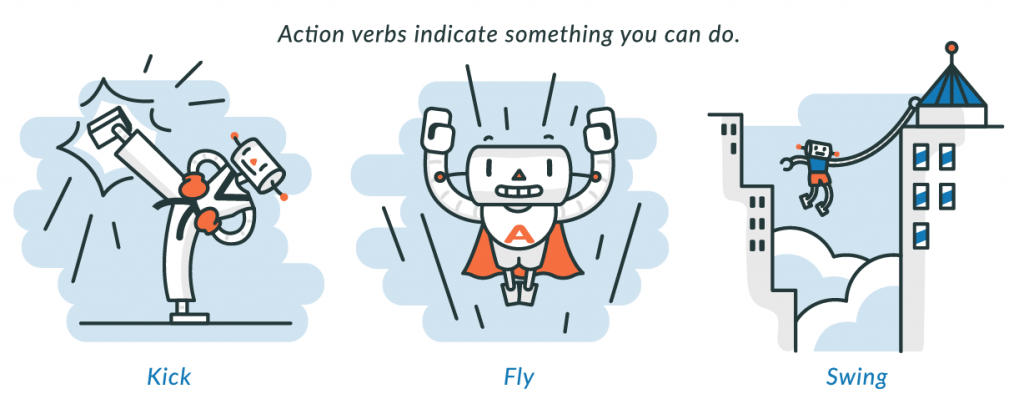
What is an action verb?
An action verb describes an action that a person, animal, object, or process in nature can do. For example, a cheetah chases gazelles across a plain, and the gazelles sprint away, hearing the tall grass rustle underneath the lion’s paws.
In the sentence above, there are several verbs that describe action; the cheetah chases the gazelles, and the gazelles hear the grass rustle and sprint away.

How are action verbs different from auxiliary verbs?
While action verbs are typically the main verb of the sentence and express the action being done by the subject, auxiliary verbs “help” the main action verb by expressing tense, mood, or voice.
For example, if the gazelles were no longer being chased by the cheetah, the sentence would read: The gazelles were chased by the cheetah and would have been caught if the cheetah would not have stubbed his toe on a rock.

Let’s take this sentence apart, because there is a lot going on!
In the sentence above, there are three action verbs: chased, caught, and stubbed.
However, there are also several auxiliary verbs that add meaning to both the action verbs and the overall sentence. These auxiliary verbs are: were, would, have, and been. Were, have, and been are auxiliary verbs that express tense, or when the cheetah chased the gazelles.
The auxiliary verb would expresses possibility. It was very possible that the gazelles would have been the cheetah’s breakfast if the cheetah had not stubbed his toe.
If you want to read more about auxiliary verbs, check out this post on Albert.
How are action verbs different from linking verbs?
Action verbs and linking verbs are alike in that they can both be the main verb of a sentence. However, they are different in that linking verbs cannot show action. Ever. Linking verbs can only show a state of being or condition.
For example, Kevin was tired of asking Joe for his Netflix password, so he finally bought his own subscription.
In this sentence, the linking verb was is the main verb of the first clause. This linking verb “links” or connects the subject, Kevin, to his current state of being, which is tired. There is also an action verb in the second independent clause of this sentence. Because Kevin was tired of bugging his friend, he took action when he bought a Netflix subscription.

What is the relationship between these different types of verbs?
To recap what we learned above, actions verbs and linking verbs can stand on their own in sentences as the main verb, even though they have very different functions. Sentences can have both action and linking verbs in the same sentence, but they have to be in separate clauses.
Here is what it might look like:
When Carlos and Suzanne rode the Haunted Mansion ride at Disney World, Carlos thought he might be scared, but Suzanne assured him that the ride was more silly than scary.
In the sentence above, rode, thought, and assured are all action verbs. Each of these action verbs are connected to a subject. Both was and be are linking verbs. Each of these linking verbs are also connected to their own subjects.
Conversely, action verbs can exist without auxiliary verbs, but auxiliary verbs must be connected to a main verb, whether it is an action or linking verb, to make sense.
Let’s look at the sentence above one more time:
When Carlos and Suzanne rode the Haunted Mansion ride at Disney World, Carlos thought he might be scared, but Suzanne assured him that the ride was more silly than scary.
If you look closely, you’ll see that there is an auxiliary verb attached to a linking verb. The auxiliary verb, might, is attached to the linking verb, be.
Two things are going on here: while the linking verb, be, expresses a state of being (Carlos is scared!), the auxiliary verb, might, helps the reader understand that Carlos is not actually scared right now, but there is a possibility that he could be scared later.

How do you use action verbs?
Simply put, writers use action verbs in sentences to express an action done by a person, an animal, an object, or nature.
For example, a postal worker delivering mail, a cat meowing, a ball rolling, or a flower blooming are all action verbs.

Return to the Table of Contents
3 Tips for Understanding Action Verbs
Here are some important tips to help you understand action verbs:

Tip #1. Action verbs must describe an action–not a state of being
- For example, the sentence, “the sun scorched the parched desert sand” uses an action verb to describe an action done by the hot sun.
- You would NOT use an action verb to say that “the sun is hot” because the verb, is, is a linking verb that describes a state of being

Tip #2. Action verbs and linking verbs can be used together, but they must be in separate clauses
- For example, Marcus played Fortnite until 2 in the morning last night, so he was too tired to get up for school the next morning.
- In this sentence, played is an action verb describing an action done by Marcus in the first clause. Then, in the second clause, a linking verb is used to show Marcus’ state of being: Marcus was tired.

Tip #3. Action verbs can be paired with auxiliary verbs to express tense, mood, or voice
- For example, Laura Jean should tell Will that she has feelings for him, but she is too nervous.
- In this sentence, the auxiliary verb, should, shows the reader that Laura Jean has not told Will how she feels about him, but the writer believes that she should.

Return to the Table of Contents
Applying the Basics: Action Verb Review & Practice
Now that you understand how action verbs are used, review the anchor chart below and complete the review to test your knowledge of these verbs.
The Ultimate List of Action, Linking, and Auxiliary Verb Examples
Refer to the graphic below to learn the difference between these three types of verbs:
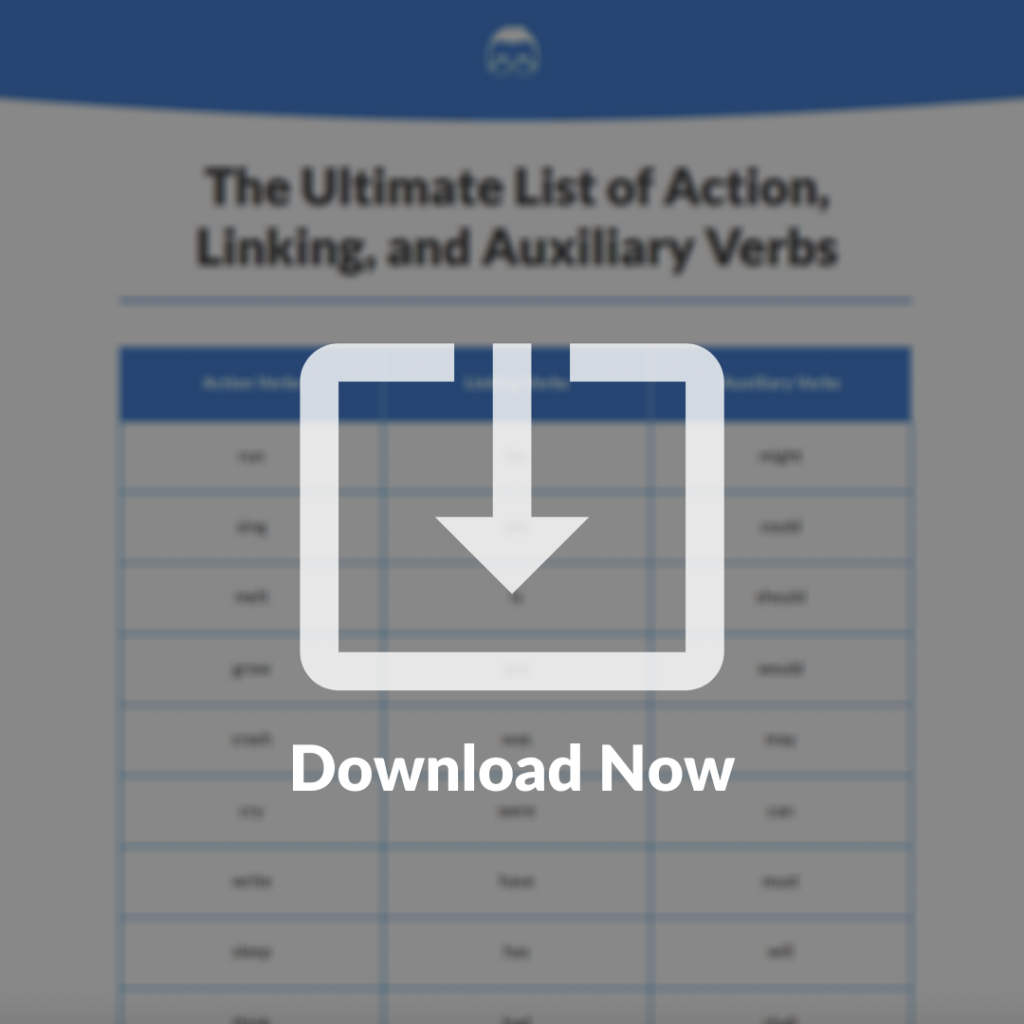
This list, obviously, does not include all action, linking, and auxiliary verbs; however, it is meant to be used as a guide while identifying these types of verbs.
Return to the Table of Contents
Action Verb Exercises and Review
Now that you know some common action verbs, test your ability to accurately identify these verbs.
Select the action verb(s) in the sentences below. Remember, these verbs must describe action and not a state of being.
1. Esperanza could not wait to celebrate her upcoming quinceanera with her family and closest friends.
- In this sentence, wait is the only action verb. While there are other verbs in this sentence, this is the only one that describes action.

2. The crowd exploded with cheers as the hockey puck slid through the goalie’s legs and into the goal.
- In this sentence, exploded and slid are both examples of action verbs. Exploded describes the loud cheers of the crowd of people, and slid describes how the hockey puck narrowly made it into the goal.
3. Alexis stared gloomily out of her bedroom window as the rain poured down unceasingly.
- In this sentence, both stared and poured are action verbs. Stared describes an action done by Alexis, while poured describes an action performed by the rain.
4. The cat reared its back and hissed through its teeth even though the excited lab only wanted to play.
- In this sentence, reared, hissed, and wanted are all examples of action verbs. Reared and hissed are actions performed by the cat, while wanted expresses an action done by the dog.
5. As the runners approached the final mile, they ignored their screaming legs and pushed themselves even harder.
- In this sentence, approached, ignored, and pushed are all action verbs that describe the runners.

Pro tip: When evaluating whether a verb is an action verb, ask yourself, is this verb describing an action that can be performed by a person, an animal, an object, or nature? If it is not describing an action but rather a state of being, then it is NOT an action verb.
For additional practice, check out Action Verb content on Albert.
Return to the Table of Contents
Try for Yourself: Action Verbs Quiz

Feeling confident in your understanding of action verbs?
Take this short six-question quiz to see what you’ve learned:
1. Does an action verb have to include an auxiliary or helping verb in order to make sense?
- Answer: No
- Correct Explanation: That’s right! An action verb can stand on its own without an auxiliary verb. Auxiliary verbs are only added if the writer wants to express tense, mood, or voice.
- Incorrect Explanation: Sorry, that’s not right! Remember, an action verb can stand on its own as the main verb of a sentence. While auxiliary verbs can be used with action verbs, they are not required.
2. Can an action verb be used in the same sentence as a linking verb as long as these verbs are in different clauses?
- Answer: Yes
- Correct Explanation: That’s right! Action and linking verbs can be used together in the same sentence, but they must be in separate clauses.
- Incorrect Explanation: Sorry, that’s not right! Remember, both action verbs and linking verbs can both function as the main verb of the sentence. This means that if you have a sentence with multiple independent clauses, you can have more than one main verb.
3. In this sentence, are the underlined words action or linking verbs?
As she spoke, her lips moved but no sound came out, then suddenly, her hands formed words in sign language as quickly as she mouthed them.
- Answer: Action
- Correct Explanation: That’s right! The verbs spoke, moved, came, formed, and mouthed are all examples of action verbs because they describe actions done by the girl.
- Incorrect Explanation: Sorry, that’s not right! Remember, an action verb must express action while linking verbs must express a state of being.
4. In this sentence, are the underlined words action or linking verbs?
When he was first rescued, the Pit Bull puppy was scared and trembling, but as soon as he knew he was safe and had a loving home, he was happy.
- Answer: Linking
- Correct Explanation: That’s right! The verbs was and had are linking verbs that connect the subject, the Pit Bull puppy, to his changing state of being.
- Incorrect Explanation: Sorry, that’s not right! Remember, a linking verb connects the subject to a state of being.
5. In this sentence, are the underlined words action or auxiliary verbs?
The caterpillar burst out of his chrysalis as a radiant butterfly.
- Answer: Action
- Correct Explanation: That’s right! The verb burst is an example of an action verb because it describes an action done by the caterpillar.
- Incorrect Explanation: Sorry, that’s not right! Remember, an action verb must express action while linking verbs must express a state of being.
6. In this sentence, are the underlined words action or auxiliary verbs?
You may go to bed late, but you may not eat five cartons of ice cream.
- Answer: Auxiliary
- Correct Explanation: That’s right! The verb may “helps” the action verbs express permission and is an auxiliary verb.
- Incorrect Explanation: Sorry, that’s not right! Remember, an auxiliary verb must connect to an action or linking verb to make sense, and auxiliary verbs exist to “help” verbs express tense, voice, or mood.
For additional practice with action verbs, check out our practice on Albert: Action Verbs.
Return to the Table of Contents
Teacher’s Corner for Action Verbs
While it’s true that understanding the difference between these three types of verbs is a foundational grammar skill, the Common Core English Language Progressive Skills Chart shows that even elementary-level skills require regular practice in the upper grades.
The Common Core State Standards site is a great resource that lists specific standards addressing action verbs.
Albert’s action verb practice can easily be implemented in the classroom for various grade levels. These short practice assignments are great for homework, bell work, mini-lessons, and exit tickets.
We also provide full-fledged assessments to evaluate student understanding of these grammatical concepts, but if you prefer, you can select different concepts to craft your own assessments to best fit your students’ needs.
Return to the Table of Contents
Summary for Action Verbs
Action Verbs describe an action that can be done by a person, an animal, an object, or nature.
Linking Verbs describe a state of being.
Auxiliary Verbs help action and linking verbs by adding tense, mood, or voice to these verbs.
Be sure to check out our grammar course for more action verb practice.
You can also access over 3,400 high-quality questions that address nearly every grammatical concept.
Need help preparing for your Grammar exam?
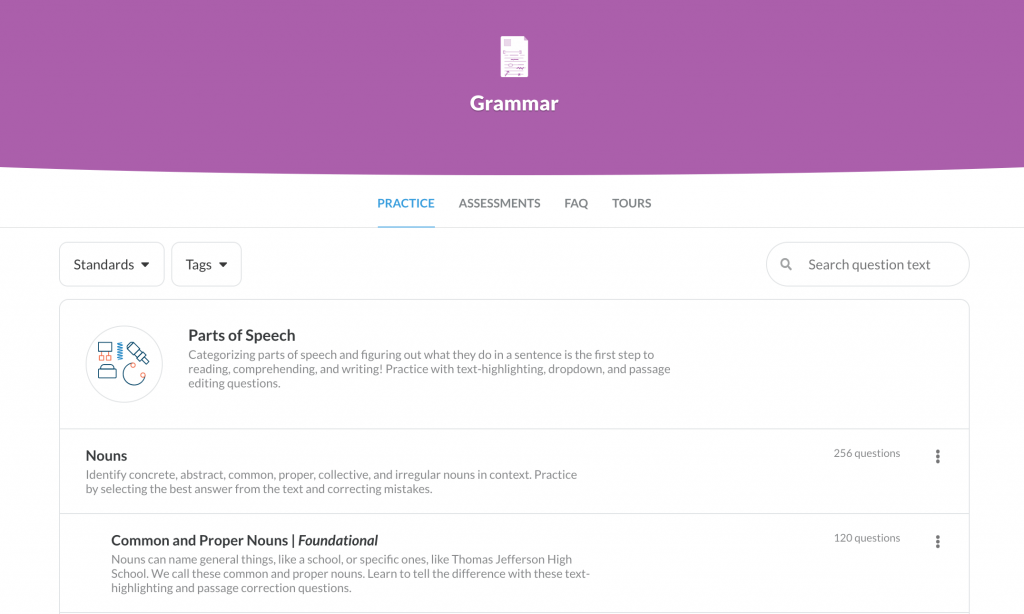
Albert has hundreds of grammar practice questions with detailed explanations to help you master concepts.

